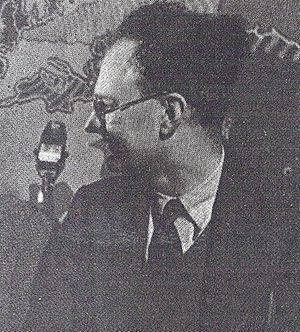Pat Dixon
Pat Dixon | |
|---|---|
 | |
| Born | Patrick Kenneth Macneile Dixon 15 June 1904 |
| Died | 8 October 1958 (aged 54) |
| Occupation(s) | Radio producer, journalist |
| Years active | 1940–1957 |
| Known for | The Goon Show |
Patrick Kenneth Macneile Dixon (15 June 1904 – 8 October 1958) was an English radio producer for BBC Radio.
Biography
Dixon was born on 15 June 1904; his parents were Professor William Macneile Dixon[1] (1891–1946) and Edith (née Wales, ?–1945).[2] He was educated at Winchester College and Christ Church, Oxford.[1]
Dixon worked for a time as a journalist with the Glasgow Herald,[3] and then in the publicity section of [[w:Gaumont-British]|Gaumont British]] before moving to the advertising agency Mather & Crowther.[4] He joined the BBC in October 1940 as a producer and, in the summer of 1948, produced Listen, My Children, a series which included Harry Secombe and Benny Hill in the cast.[5][6] At the end of 1948 he produced the radio series Third Division, which was broadcast in early 1949; the shows were written by Frank Muir and Denis Norden and the cast included Secombe, Michael Bentine and Peter Sellers.[7] Bentine noted that Dixon was "scholarly and intelligently humorous ... and as radical in his approach to comedy as we were",[8] while Muir considered him "a terrific chap, and a rebel ... he started all sorts of ideas and shows.[9]
In 1951 Dixon agreed to a request from Spike Milligan to record an audition tape which included Milligan, Sellers, Bentine and Secombe; he passed the tape on to the BBC planners and stressed that a series would be an asset to the corporation. They agreed and Crazy People was produced, which was subsequently re-named The Goon Show, although Dixon was not the producer.[10] Dixon had a further impact on the show as he introduced Max Geldray and Ray Ellington into the format.[11] Towards the end of the sixth series of The Goon Show, the regular producer, Peter Eton, left the show to work on BBC television: Dixon became the show's producer for the remaining six episodes.[12] Dixon was less disciplinarian than Eton in his approach,[13] although there was some friction with Milligan and Eton returned to produce the first two shows of series seven, before Dixon completed the rest of the 25 episode series.[14][15] His last Goon Show was broadcast on 28 March 1957.[14] During his tenure as Goon Show producer, Dixon came under pressure from the BBC to ensure no overtly political references or jokes were in the script; he resented such coercion, and wrote to the Assistant Head of Variety, "I think it is very dangerous to have these subtle encroachments on free speech".[16] Spike Milligan considered that Dixon was, "the only producer ... who knows what the Goon Show is all about".[17]
Dixon worked with Tony Hancock, when he produced the first episode of the fifth series of Hancock's Half Hour, The New Radio Series.[18] He also produced the series Ignorance is Bliss and These Foolish Things.[1] Dixon also worked again with Michael Bentine on the first series of Round the Bend in Thirty Minutes.
He died of cancer on 8 October 1958, aged 54.[19][1]
Selected credits
- Take It From Here (Radio)
- It's That Man Again (Radio, 1941–44)
- Tom Arnold's Hoop-La! (Radio, 1944–45)
- It's a Pleasure (Radio, 1945)
- Our Shed (Radio, 1946)
- Ignorance is Bliss (Radio, 1947–1949)
- Night Comes too Soon (Film script, 1947)
- Listen, My Children (Radio, 1948)
- Third Division (Radio, 1949)
- The Bradens (Radio, 1950–1956)
- Let's Settle For Music with the Baker's Dozen (Radio, 1952-?)
- In All Directions (Radio, 1952–55)
- Starstruck (Radio, 1955)
- Finkel's Café (Radio, 1956)
- These Foolish Things (Radio, 1956)
- The Goon Show (Radio, 1956–1957)
- Passing Parade (Radio, 1957)
- Round the Bend in Thirty Minutes (1957–58)
- Hancock's Half Hour (Radio, 1958)
Notes and references
Notes
References
- ^ a b c d "Obituary: Mr. Pat Dixon". [[w:The Times|]]. London. 10 October 1958. p. 89.
- ^ "Dixon, William Macneile". Who's Who. Oxford: [[w:Oxford University Press|]]. Retrieved 16 August 2012. (subscription required)
- ^ "BBC Variety Producer". The Herald. Glasgow. 9 October 1958. p. 9.
- ^ Meynell, Francis (14 October 1958). "Pat Dixon". [[w:The Times|]]. London. p. 13.
- ^ Carpenter 2004, p. 96.
- ^ Secombe 1997, p. 166.
- ^ Carpenter 2004, pp. 95–96.
- ^ Carpenter 2004, p. 105.
- ^ Carpenter 2004, pp. 105–06.
- ^ Wilmut & Grafton 1981, p. 34.
- ^ Carpenter 2004, p. 114.
- ^ Wilmut & Grafton 1981, p. 124.
- ^ Carpenter 2004, p. 166.
- ^ a b Wilmut & Grafton 1981, p. 126.
- ^ Carpenter 2004, p. 173.
- ^ Carpenter 2004, pp. 174–75.
- ^ Carpenter 2004, p. 184.
- ^ Webber 2011, p. 137.
- ^ Wilmut & Grafton 1981, p. 63.
Bibliography
- Carpenter, Humphrey (2004). Spike Milligan. London: Hodder & Stoughton. ISBN 978-0-340-82612-6.
- Secombe, Harry (1997). Arias and Raspberries: An Autobiography. London: Pan Macmillan. ISBN 978-0-330-35463-9.
- Webber, Richard (2011). Fifty Years of Hancock's Half Hour. London: Random House. ISBN 978-1-4464-0998-5.
- Wilmut, Roger; Grafton, Jimmy (1981). The Goon Show Companion: A History and Goonography. London: Robson Books. ISBN 0-903895-64-1.
External links
- Pat Dixon at the British Film Institute